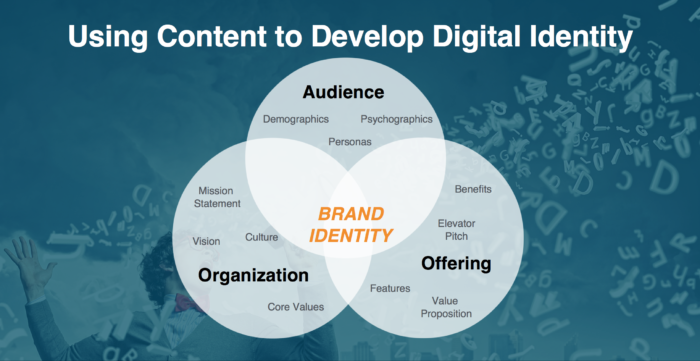Creating a social content strategy guarantees that your digital brand is conveyed correctly and consistently. You must know the necessary steps to implement your strategy. Continue reading to learn the blueprint to creating a social content strategy for your brand.
How to Create a Social Content Strategy for Your Brand
Before I get started, I want to highlight that it’s crucial to have a strong understanding of your target audience, their needs, and most importantly, what they can gain from your content when you develop a social content strategy.
A good social content strategy involves a voice that your audience will recognize. This voice isn’t a bland industry message, it’s an approachable human resource that naturally meets the consumer’s needs.
Here’s the first step.
Social Content Strategy Step One: Define Your Brand Story
Start by defining the story surrounding your brand. Often, inspiration can be taken from the mission defined in your business plan. But, you must focus on what’s at the heart of your brand, and how your product or service makes a difference.
SEE ALSO: How to Tell Your Digital Brand Story
What’s Your Brand Purpose
Content is one of the key parts of the strategy when working towards your long-term goals for social media. Content should always be aligned with the social media strategy, and with the goals you’ve defined. That is, if your overall goals for social focuses on awareness and engagement, tailor your content accordingly.
Creating content deliberately and thoughtfully, and giving forethought to the action you want the user to take with your content, is key when sparking engagements.

Examples of content purposes:
- Reach – typically, these are messages designed for paid distribution
- Engagement – actions like comments, likes, shares, retweets, repins, favorites etc.
- Consumption – photo views, video plays, Twitter’s detail expands, Facebook’s “other post clicks”
- Insight – product feedback or asking your users which kind of content they would like to see from you
- Conversion – converting a fan/follower, event sign-ups, offer and promo code claims, or newsletter sign ups
- Traffic – to website or App Store and Google Play
What’s Your Tone of Voice
Today’s consumer is bombarded with so many messages so you need to establish a clear brand voice to rise above other messages. You need to define the guidelines for how you communicate verbally (and non-verbally) on social media.

To get you started, here are a few tips.
- Think about the values and brand image you want to project. What type of language supports that image?
- Write down a short description of how you communicate. This could be an example: “our brand provides down-to-earth expertise and accessible inspiration on cooking and food. Our brand is not about fine dining, but the quality everyday meal that you enjoy with family and friends….”
- Write a list of rules of thumb to guide your content creation. These are typically a mix of general best practice and company-specific issues. For instance, “we communicate in short and simple sentences, we don’t use slang or jargon, and we don’t use these particular words when talking about our products.”
Naturally, we often find that tone of voice is taken to mean verbal tone of voice. In fact, pinning down your visual tone of voice is even more important, because most social media networks prioritize visual content.
SEE ALSO: How to Use Social Media to Develop Your Digital Brand Voice
Social Content Strategy Step Two: Plan Your Content

Planning ahead is paramount in creating a social content strategy. If you’re responsible for social media, you’re typically heavily strapped for time and wear many hats. To ensure a steady flow of quality content, you need to establish tactics around executing your social content strategy.
The tactics consist of mapping audience segmentation, content themes, planning your content calendar, and tracking performance.
Let’s take a dive into each one.
Map Your Audiences

Consider segmenting your content based on the different levels of target group relationship with your brand or vertical. That is, create some content for followers/fans, and other content for nonfans.
Both groups should always match your actual target group. Consider crafting content tailored for the different steps of the customer lifecycle, if this makes sense for your digital brand.
Create Content Themes
When looking at your content themes, carefully consider the type of content you will be creating. As a rule of thumb, good content is a mix of curated, creative and commercial.
Depending on your brand and your position in the market, this balance should be individually defined, but be careful not to post too much commercial content, as it tends to cause audiences to lose interest.
SEE ALSO: Content Planning Tips To Compete with Big Brands
Social Content Strategy Step Three: Create Your Content Calendar
The content calendar is an overview of the content going out on social media for a set period of time. Typically, content calendars span a period of a month or two. Anything longer than that and you run the risk of posting outdated messages. Remember, social media chatter moves fast. Be sure to include space for real-time content.
Additionally, you should keep an eye on activities further into the future so you can properly plan the execution of campaigns and other big events. Lastly, I highly recommend not creating actual updates for longer than two months at a time.

When working with content, try mapping out the year in content. Determine how many posts a week you’ll have, and how many pieces of content that add up to.
Most brands underestimate the time and resources necessary to keep up a steady flow of content throughout the year, so think about what you’re able to do and your dry spells throughout the year.
You can’t plan ahead to the same extent when working with curated content; it requires more ad hoc work. But if you’ve covered your creative and commercial content in advance, you have more time to spend sourcing content.
Social Content Strategy Step Four: Track Brand Performance
There are two sides to tracking and analytics on social media. One is to prove digital branding ROI, the other is to learn more about your content and your community. This should be done all with the purpose of revising your approach to improve performance.

Measure performance and value
Taking a look at the performance of your social media presence is key when proving the value of social media and tracking progress with your long-term social media objectives.
It’s always best to look beyond social metrics when trying to prove the value of social. Broader digital metrics like page visits and time on your website make excellent KPIs for determining volume and quality of your social media efforts.
The actual metrics to prioritize depend on your objectives and social content strategy.
Here are some of my favorites:
Conversions
Define the various conversion targets along the sales cycle. Don’t simply think of the end goal in terms of direct revenue, but determine the value of softer targets such as event sign-ups, brochure downloads, campaign offer claims etc.
Quality and value of traffic
For traffic generated by social media, use a web analytics tool to determine the value and quality of this traffic. How do social users compare to other types of users in terms of page views, bounce rate, session duration, conversion?
You may be able to convince your boss to allocate more budget to social if he sees that conversion rates for social are twice what they are for display advertising.
Reach
This directly translates to the good old awareness or exposure factor.
Development of community
Is your fan/following count increasing, declining or remaining steady?
Focus on the composition and general health of your following, not vanity metrics such as the number. A constant increase in fans is not necessarily the best for your brand.
Content Performance
Social media changes constantly, so what worked 6 months ago when you created your social content strategy may not work today. People will defy your preconceptions of what they might like and not like.
So, make sure you’re regularly looking at data to determine if you need to tweak your approach. To do so, use actionable insights and data displaying the details of content performance. Here, you’re looking at the micro level view, whereas measuring performance and value deals with the macro, big picture of your social media activity.
Here, you’re looking at the micro level view, whereas measuring performance and value deals with the macro, big picture of your social media activity.

Final Thoughts
Drawing upon every facet of your digital brand, your social content strategy will ensure you get the most out of your social media efforts. When there are clear lines between the needs of your audience and the corresponding content, you know you have successfully developed an effective social content strategy.
Do you believe there’s a difference between a social content strategy and a content marketing strategy? If so, how? Leave a comment in the section below…











